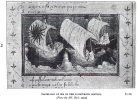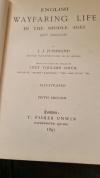scruffy1
Veteran Member
- Time of past OR future Camino
- Holy Year from Pamplona 2010, SJPP 2011, Lisbon 2012, Le Puy 2013, Vezelay (partial watch this space!) 2014; 2015 Toulouse-Puenta la Reina (Arles)
There are many 'What a lovely wonderful day that was' on the Camino but there are also days that are more difficult, 'Thank Goodness that's over'. History shows us that such was always the pilgrims' role.
14th Century Pilgrimage to SdC
Licensees authorizing the owners and captions of ships to carry a fixed number of pilgrims to Spain are still in existence and fill many pages of Thomas Rymer’s book 'Foedera'. They are written in Latin, the name of the ship in French. The pilgrims must swear before leaving England: they must upon their oath do nothing contrary to the obedience and fealty they owe the king; they must not take out of the realm gold or silver or bullion beyond what is necessary to their journey, and they must not reveal the secrets of the realm. Don’t think for a minute that these ships, one hundred pilgrims and crew on a long journey were large, well-appointed vessels. The pilgrims suffered from overcrowding, seasickness, the fear of storms, disgusting smells, and the derision of the sailors. They very much resembled the jam-packed pilgrim ships on the Red Sea of our recent history which brought crowds of believers to Jeddah, Muslims on their way to Mecca. Our example dates from 1394: “Know you that we have given license to Oto Chambernoun, William Gilbert, and Richard Gilbert, to receive and embark in the harbor of Dartmouth a hundred pilgrims in a certain ship belonging to the same Oto, William, and Richard, called la Charite de Paynton, of which Peter Cok I captain; and to take them to Saint James, there to fulfill their vows, and from thence to bring them back to England, freely and without hindrance, notwithstanding ordinances to the contrary.
We got it easy.
14th Century Pilgrimage to SdC
Licensees authorizing the owners and captions of ships to carry a fixed number of pilgrims to Spain are still in existence and fill many pages of Thomas Rymer’s book 'Foedera'. They are written in Latin, the name of the ship in French. The pilgrims must swear before leaving England: they must upon their oath do nothing contrary to the obedience and fealty they owe the king; they must not take out of the realm gold or silver or bullion beyond what is necessary to their journey, and they must not reveal the secrets of the realm. Don’t think for a minute that these ships, one hundred pilgrims and crew on a long journey were large, well-appointed vessels. The pilgrims suffered from overcrowding, seasickness, the fear of storms, disgusting smells, and the derision of the sailors. They very much resembled the jam-packed pilgrim ships on the Red Sea of our recent history which brought crowds of believers to Jeddah, Muslims on their way to Mecca. Our example dates from 1394: “Know you that we have given license to Oto Chambernoun, William Gilbert, and Richard Gilbert, to receive and embark in the harbor of Dartmouth a hundred pilgrims in a certain ship belonging to the same Oto, William, and Richard, called la Charite de Paynton, of which Peter Cok I captain; and to take them to Saint James, there to fulfill their vows, and from thence to bring them back to England, freely and without hindrance, notwithstanding ordinances to the contrary.
We got it easy.













